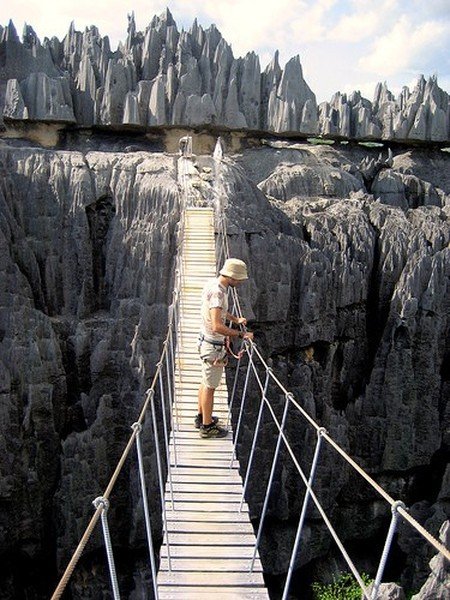|
|
Stone Forest In Madagascar, Manambulu - Bemaraha
|
History
• Early history
Most archaeologists estimate that the earliest settlers arrived in outrigger canoes from southern Borneo between 200 BCE and 500 CE, making Madagascar one of the last major landmasses on Earth to be settled by people. Upon arrival, early settlers practiced tavy (swidden, slash-and-burn agriculture) to clear the virgin coastal rainforests for the cultivation of their crops. The first settlers encountered Madagascar's wealth of megafauna, including giant lemurs, elephant birds, giant fossa and the Malagasy hippopotamus, which have since become extinct due to hunting and habitat destruction. By 600 CE groups of these early settlers had moved inland and began clearing the forests of the central Highlands. Irrigated rice paddies emerged in highland Betsileo country by 1600 and were complemented with terraced paddies throughout Imerina a century later. Zebu were introduced around 1000 CE by Bantu-speaking East African migrants who maintained large herds. The rising intensity of land cultivation and the ever-increasing demand for zebu pasturage in the central highlands had largely transformed the region from a forest ecosystem to barren grassland by the 17th century. Merina oral histories tell of migration from the southeast coast to the central highlands where the Merina encountered an established population called the Vazimba, who may have been the descendants of an earlier and less technologically advanced Austronesian settlement wave. The Vazimba were vanquished by Merina kings Andriamanelo, Ralambo and Andrianjaka in the 16th and early 17th centuries.
Madagascar was an important transoceanic trading hub connecting ports of the Indian Ocean in the early centuries following human settlement. The written history of Madagascar begins in the 7th century when Arabs established trading posts along the northwest coast and introduced Islam, the Arabic script (used to transcribe the Malagasy language in a form of writing known as sorabe), Arab astrology and other cultural elements. European contact began in 1500, when the Portuguese sea captain Diogo Dias sighted the island. The French established trading posts along the east coast in the late 17th century. From about 1774 to 1824, it gained prominence among pirates and European traders, particularly those involved in the trans-Atlantic slave trade. The small island of Nosy Boroha off the northeastern coast of Madagascar has been proposed by some historians as the site of the legendary pirate utopia of Libertalia. Many European sailors were shipwrecked on the coasts of the island, among them Robert Drury, whose journal is one of the few written depictions of life in southern Madagascar during the 18th century. The wealth generated by maritime trade spurred the rise of organized kingdoms on the island, some of which had grown quite powerful by the 17th century. Among these were the Betsimisaraka alliance of the eastern coast and the Sakalava chiefdoms of Menabe and Boina on the west coast. The Kingdom of Imerina, located in the central highlands with its capital at the royal palace of Antananarivo, likewise emerged at around the same time under the leadership of King Andriamanelo.
|
|









